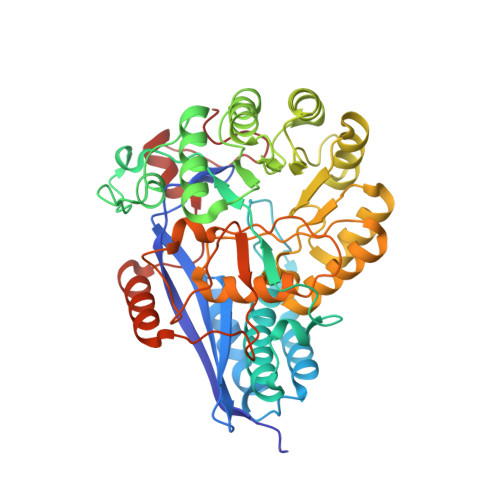Evolution of enzymatic activities in the enolase superfamily: identification of the general acid catalyst in the active site of D-glucarate dehydratase from Escherichia coli.
Gulick, A.M., Hubbard, B.K., Gerlt, J.A., Rayment, I.(2001) Biochemistry 40: 10054-10062
- PubMed: 11513584
- DOI: https://doi.org/10.1021/bi010733b
- Primary Citation of Related Structures:
1JCT, 1JDF - PubMed Abstract:
D-Glucarate dehydratase from Escherichia coli (GlucD), a member of the enolase superfamily, catalyzes the dehydration of both D-glucarate and L-idarate to form 5-keto-4-deoxy-D-glucarate (KDG). Previous mutagenesis and structural studies identified Lys 207 and the His 339-Asp 313 dyad as the general basic catalysts that abstract the C5 proton from L-idarate and D-glucarate, respectively, thereby initiating the reaction by formation of a stabilized enediolate anion intermediate [Gulick, A. M., Hubbard, B. K., Gerlt, J. A., and Rayment, I. (2000) Biochemistry 39, 4590-4602]. The vinylogous elimination of the 4-OH group from this intermediate presumably requires a general acid catalyst. The structure of GlucD with KDG and 4-deoxy-D-glucarate bound in the active site revealed that only His 339 and Asn 341 are proximal to the presumed position of the 4-OH leaving group. The N341D and N341L mutants of GlucD were constructed and subjected to both mechanistic and structural analyses. The N341L but not N341D mutant catalyzed the dehydrofluorination of 4-deoxy-4-fluoro-D-glucarate, demonstrating that in this mutant the initial proton abstraction from C5 can be decoupled from elimination of the leaving group from C4. The kinetic properties and structures of these mutants suggest that either Asn 341 participates in catalysis as the general acid that facilitates the departure of the 4-leaving group or is essential for proper positioning of His 339. In the latter scenario, His 339 would function not only as the general base that abstracts the C5 proton from D-glucarate but also as the general acid that catalyzes both the departure of the 4-OH group and the stereospecific incorporation of solvent hydrogen with retention of configuration to form the KDG product. The involvement of a single functional group in this reaction highlights the plasticity of the active site design in members of the enolase superfamily.
Organizational Affiliation:
Department of Biochemistry, University of Wisconsin, Madison, Wisconsin 53706, USA.

















